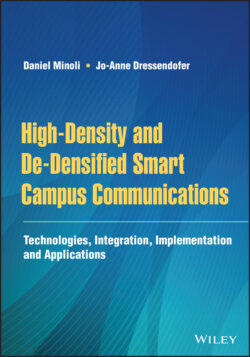Читать книгу High-Density and De-Densified Smart Campus Communications - Daniel Minoli - Страница 38
2.5 KEY IEEE 802.11AC MECHANISMS
ОглавлениеNew mechanisms were introduced with 802.11ac [18] to increase nominal speed and throughput. A DL channel refers to a communication channel from a transmit antenna of the AP to a receive antenna of a WN/STA, and an UL channel refers to a communication channel from a transmit antenna of a WN/STA to a receive antenna of the AP; DL and UL may be referred to as forward link and reverse link, respectively. New mechanisms 802.11ac included but were not limited to: (i) extended channel binding; (ii) optional 160 MHz and mandatory 80 MHz channel bandwidth for stations; (iii) (as noted), more MIMO spatial streams, also with Downlink Multi‐User MIMO (DL‐MU‐MIMO) – this DL‐MU‐MIMO formulation allows up to four simultaneous clients; (iv) multiple STAs (WNs) each having one or more antennas, to transmit or receive independent data streams simultaneously; (v) 256‐QAM, rate 3/4 and 5/6, added as optional modes (as compared with 64‐QAM, rate 5/6 maximum in 802.11n); and (vi) beamforming with standardized sounding and feedback for compatibility between vendors. Some features (e.g. low‐density parity‐check code; 400 ns short guard interval; five to eight spatial streams; 160 MHz channel bandwidths – contiguous 80 + 80; and 80 + 80 MHz channel bonding including discontiguous sections [19]) are optional.
